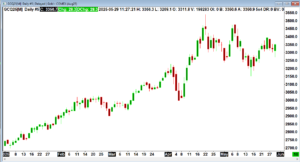
Gold Futures (GC) – Sierra Charts
Jan 1, 2025 – May 29, 2025
In a year marked by economic uncertainty and market volatility, gold futures have become a desirable choice for some investors seeking stability. As of May 29, 2025, gold futures are trading around $3,292.50 per ounce, reflecting a robust performance amidst global financial upheavals.
A Safe Haven in Stormy Markets
The stock market experienced significant turbulence in April 2025, triggered by the announcement of sweeping tariffs by President Donald Trump. Dubbed “Liberation Day,” these tariffs led to a sharp decline in equities, with the S&P 500 and Dow Jones Industrial Average experiencing substantial losses. In contrast, gold futures surged as investors sought refuge from the escalating trade tensions and market instability.
Central Banks and Institutional Demand Fuel Growth
A key driver behind the ascent of gold prices has been the sustained demand from central banks and institutional investors. Countries like China, India, and Turkey have ramped up their gold purchases, aiming to diversify reserves amidst a weakening U.S. dollar and geopolitical uncertainties.
Analyst Projections and Market Outlook
Many financial analysts remain optimistic about gold’s trajectory. Goldman Sachs projects that gold could reach $3,700 per ounce by the end of 2025, driven by factors such as central bank acquisitions and investor hedging against inflation.
Short-Term Volatility and Technical Considerations
Despite the overall bullish sentiment, gold has not been immune to short-term fluctuations. Recent technical analyses indicate that gold is in a short-term downtrend – these movements reflect the dynamic interplay of market forces and investor sentiment.
Gold Miners’ Strategic Positioning
Interestingly, gold mining companies have largely refrained from hedging their production, opting instead to capitalize on the high prices. This strategy reflects confidence in sustained demand and favorable market conditions.
Conclusion
In the face of stock market volatility and economic uncertainty, gold futures have demonstrated resilience and appeal for some traders. While central bank demand and investor sentiment have played key roles in supporting prices, short-term fluctuations and technical uncertainties remain. As economic and geopolitical factors continue to unfold, gold’s performance will likely depend on a complex mix of global trends, policy decisions, and investor behavior. For now, it remains a closely watched asset in the broader investment landscape.
Please be aware that the content of this blog is based upon the opinions and research of GFF Brokers and its staff and should not be treated as trade recommendations. There is a substantial risk of loss in trading futures, options and forex. Past performance is not necessarily indicative of future results.
Disclaimer Regarding Hypothetical Performance Results: HYPOTHETICAL PERFORMANCE RESULTS HAVE MANY INHERENT LIMITATIONS, SOME OF WHICH ARE DESCRIBED BELOW. NO REPRESENTATION IS BEING MADE THAT ANY ACCOUNT WILL OR IS LIKELY TO ACHIEVE PROFITS OR LOSSES SIMILAR TO THOSE SHOWN. IN FACT, THERE ARE FREQUENTLY SHARP DIFFERENCES BETWEEN HYPOTHETICAL PERFORMANCE RESULTS AND THE ACTUAL RESULTS SUBSEQUENTLY ACHIEVED BY ANY PARTICULAR TRADING PROGRAM.
ONE OF THE LIMITATIONS OF HYPOTHETICAL PERFORMANCE RESULTS IS THAT THEY ARE GENERALLY PREPARED WITH THE BENEFIT OF HINDSIGHT. IN ADDITION, HYPOTHETICAL TRADING DOES NOT INVOLVE FINANCIAL RISK, AND NO HYPOTHETICAL TRADING RECORD CAN COMPLETELY ACCOUNT FOR THE IMPACT OF FINANCIAL RISK IN ACTUAL TRADING. FOR EXAMPLE, THE ABILITY TO WITHSTAND LOSSES OR TO ADHERE TO A PARTICULAR TRADING PROGRAM IN SPITE OF TRADING LOSSES ARE MATERIAL POINTS WHICH CAN ALSO ADVERSELY AFFECT ACTUAL TRADING RESULTS. THERE ARE NUMEROUS OTHER FACTORS RELATED TO THE MARKETS IN GENERAL OR TO THE IMPLEMENTATION OF ANY SPECIFIC TRADING PROGRAM WHICH CANNOT BE FULLY ACCOUNTED FOR IN THE PREPARATION OF HYPOTHETICAL PERFORMANCE RESULTS AND ALL OF WHICH CAN ADVERSELY AFFECT ACTUAL TRADING RESULTS.